Koreans have always been attracted to Mt. Paektu and Mt. Kumgang for more than their exceptional scenic beauty; the two mountains have special historical, cultural and artistic significance to the nation. For South Koreans, especially, these mountains in the North are s of yearning as well as grieving.
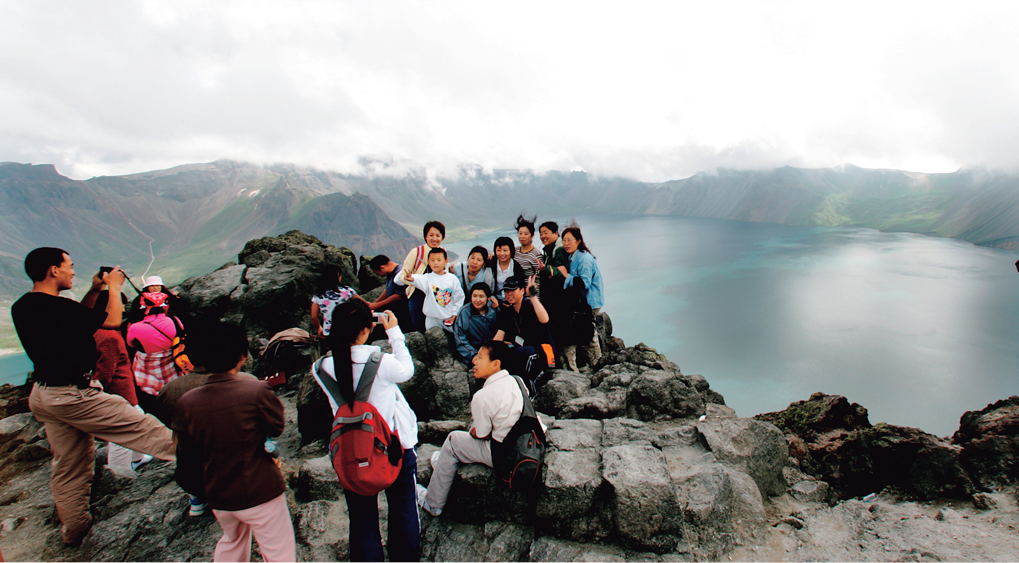
South Korean tourists take pictures by Chonji, the crater lake on top of Mt. Paektu. Straddling the border between North Korea’s Ryanggang Province and China’s Jilin Province, Mt. Paektu is the highest mountain in the Baekdu Daegan mountain range which runs 1,400 kilometers southward along the peninsula. Currently, South Koreans can only visit the mountain via China.
I was born and raised in the southern half of a divided country, where I received intense anti-communist education. North Korea, I was taught, was ruled by a puppet regime, with labor camps and rampant poverty. School exams frequently included questions about the North’s Chollima Movement, which forced the people to work without ceasing, just like the eponymous horse that gallops 1,000 li (approx. 400 km) in a single day, and the “one in five households” system, under which every five families had one member of the Workers’ Party assigned to monitor their daily lives. Every so often, newspapers reported an armed guerilla invasion, and students were sent in large groups to exhibitions to look at the grenades, daggers and other weapons that had been confiscated from the guerillas.
Anti-Communist Education
In music class, however, we would sing, “Let’s go to Mt. Kumgang with its 12,000 peaks. How beautiful and marvelous they are.” And in our Korean textbook, we read an essay on travel to the same mountain, “The Endless Delight of the Mountain” (Sanjeong muhan), and imagined the beauty of its woods, waterfalls, clouds, fog and rocks. As the landscape completely changes with the seasons, we were told, the mountain has four different names: Kumgang (also spelled Geumgang), meaning “diamond,” is its name for spring, when all 12,000 peaks are clad with fresh green leaves and flowers, sparkling like a diamond.
There is no less interest in Mt. Paektu. Above all, it is mentioned at the beginning of the Korean national anthem: “Until the day Mt. Paektu is worn away and the East Sea runs dry, God protect and bless our beloved country.” With the Kaema Plateau encircling the summit like a woman’s flared skirt, the mountain has preserved the mystery of primeval forests. Its name Paektu (also spelled Baekdu; meaning “white head”) is derived from the appearance of the summit area covered with white pumice deposits. With the majestic crags and the caldera lake Chonji (“heaven lake”), known to be the deepest of its kind in the world, the mountain has evoked the expansive spirit of the Korean nation. However, it seemed only to exist symbolically as “the nation’s spiritual sanctuary,” further abstracted by the tantalizing awareness that we could no longer visit it.
Nevertheless, history progressed, opening new doors to these hidden places. In 2002, I finally set foot on Mt. Kumgang, in a picturesque valley flanked by craggy hills. And several years later, I was on top of Mt. Paektu looking at the waters of Chonji.
The beginning of said history might be the Hyundai Group founder Chung Ju-yung’s visit to North Korea leading a herd of cattle. Born in the North, Chung came south at the age of 17 after stealing the money his father earned from selling his cow to start a business, which has grown to the conglomerate of today. In 1998, the then 83-year-old tycoon negotiated with the North and staged his homecoming to promote peace on the divided peninsula. He crossed the Demilitarized Zone through the border village of Panmunjom, leading a convoy of trucks carrying 500 head of cattle, which he said was repayment of the money he had stolen from his father. In November that year, the Hyundai Group launched a tourism business enabling South Korean citizens to travel to Mt. Kumgang. Two years later, then South Korean President Kim Dae-jung and Kim Jong-il, chairman of the DPRK National Defense Commission, met in Pyongyang and adopted the “June 15 Joint Declaration.”
The “Sunshine Policy” of President Kim Dae-jung continued to thaw the long frozen relationship between the two Koreas. One of the notable outcomes was the decision for North Korean athletes and cheerleading squad to participate in the 2002 Busan Asian Games - for the first time since the division of the country. Coincidentally, it was the same year the FIFA World Cup was to be held in the South. Thus it was planned that a group of representatives from the cultural, artistic and athletic sectors would conduct a “sunrise-viewing ceremony to pray for the success of the World Cup and the Asian Games.” As schoolchildren, my generation had been mobilized to so many public events that even as an adult, repulsion was always my first response to any kind of government-initiated event. But to think that we would go to Mt. Kumgang! Frankly, when I was invited to the event, I was truly glad that I had become a novelist.
Unfamiliar But Graceful Scenery
What was that gentle thrill that coursed through me when I first set foot on North Korean soil? What about the awkward delight I felt conversing with the first North Korean I had ever met? And what was the faint but invigorating energy that enveloped me on a solitary walk along the valley of Mt. Kumgang? As a hiking enthusiast, I have climbed many mountains in and outside of South Korea, but the “diamond mountain” was like no other. The beauty was unfamiliar yet it seemed I had longed for it.
Some members of the group complained that the propaganda slogans engraved on the rocks here and there ruined the landscape. Others found fault with the stiffness with which North Koreans treated us. But in the evening, when we looked at the faraway peaks while soaking in steamy hot springs, or at the gentle curves of the coastline stretching beautifully along the Haekumgang (“sea diamond”) area, all those ill feelings were forgotten. And then there was the hearty laughter of the local people who loved to joke around, the savory bog bilberry liquor and Taedonggang Beer.
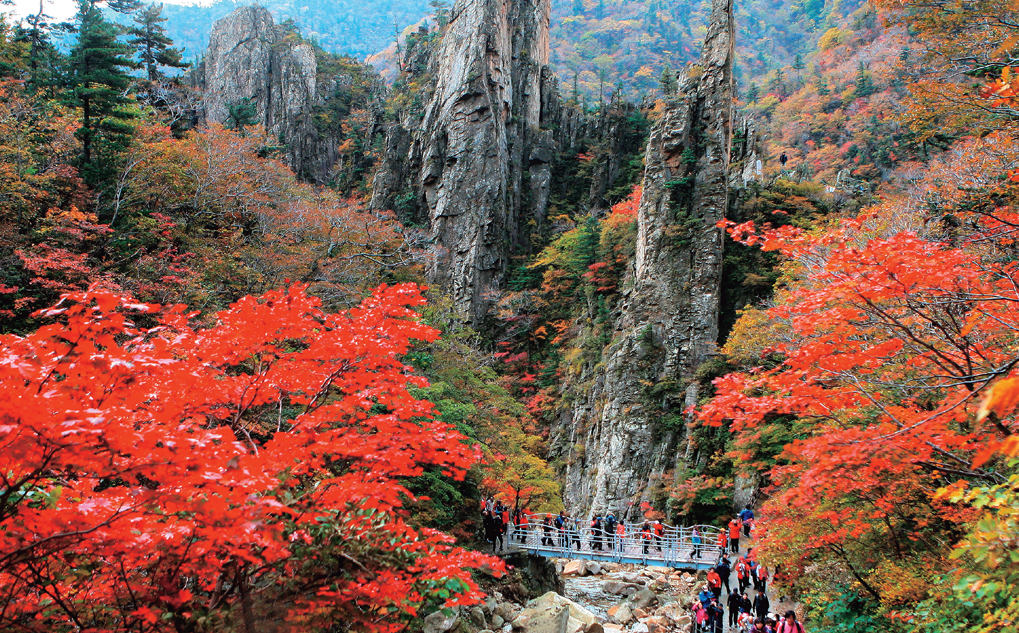
A mountain with splendid scenery that changes every season, Mt. Kumgang was mostly inaccessible for South Koreans after territorial division in 1948. A cross-border tour program was launched in 1998 to enable South Koreans to visit the mountain by a sea route, but it was discontinued in 2004. Overland travel started in 2003 but stopped in 2008.
My second chance to visit North Korea came three years later in 2005, when the Korean Writers’ Convention was held at Mt. Paektu. It was a historic event bringing together 200 Korean writers from both Koreas and overseas for the first time. Although it was a tough undertaking from the outset, our wish to get together with our own people was just as strong. Before departure, I went to a neighborhood pharmacy to prepare a small gift as the coordinators had suggested. The pharmacist was curious as to why I would need so much household medicine at one time. On learning that it would be taken to North Korea as a present, she gave me several times more than what I intended to buy and refused to take any money. “I hope everyone stays healthy and that we will all meet each other one day,” she said.
In less than an hour after the Air Koryo flight took off from Seoul, we landed at the Sunan International Airport in Pyongyang. It was a laughably short trip compared with my previous journey to Mt. Kumgang by sea, when I had been seasick all night.
Crossing the Border
Generally speaking, writers do not excel at group activities. Moreover, it was a gathering of individuals who had led disparate lives under different political systems, and what we wished to show each other was not the same as what we wished each other would see. Above all, the difference in values was a constant source of tension, conflict and misunderstanding. For instance, the South Koreans who trained their cameras on rural scenery reminding them of their home villages in the 1970s had done so out of nostalgia, but it was a grave discourtesy to the North Koreans, for whom proving the superiority of their system was a matter of self-respect.
On more than a few occasions, however, we were reminded of our shared roots. At the dinner table, when a North Korean writer called lettuce “buru,” a South Korean writer from Jeju Island was pleasantly surprised to find that what he had believed to be Jeju dialect was actually a standard word in the North. The conversation then turned to the linguistic homogeneity of the two Koreas. Although we had been divided for 60 years with little exchange, we had no trouble conversing with each other, except when words of foreign origin were used.
Mt. Paektu in Dawn Light
The Korean Writers’ Convention was scheduled at daybreak so that we could watch the rising sun from the top of Mt. Paektu. The bus carrying us departed the lodge halfway up the hillside in the predawn darkness. Most of us were asleep in the bus after a night of drinking, celebrating our friendship and the last night of the journey. It seemed that I was the only one awake.
At the prospect of presiding over the ceremony on the summit, I was too nervous to be sleepy. But thanks to my wakefulness, I saw an unforgettable scene unfolding before my eyes - the beauty of the primordial forests waking up in the crepuscular light. Around the bend, the white birch woods gave way to a copse of larch trees, among whose scaled trunks bloomed all sorts of flowers in full glory. The water was crystal clear and the dark rocks d odd silhouettes here and there. Finally, we reached the summit and stood on Changgunbong (“general peak”) when the magnificent sun rose above the blue waters of Chonji.
There, writers from the North and the South recited poems and called out slogans together, and had our pictures taken with arms around each other’s shoulders. Later, an essay about the event recalled that a writer from the South had said, “Quietly remove the ugly barbed wire,” to which a writer from the North responded by saying, “When people unite in mind, even the heavens give in.”
The optimistic atmosphere persisted. In the following year, the June 15 Commemorative Association of North and South Korean Writers was inaugurated in a ceremony held at Mt. Kumgang. There was also the “Literary Night at Mt. Kumgang,” where the writers from both sides met once again. Overland tours were operating to the mountain, so this time we did not have to suffer from seasickness. We took a bus and crossed the border to the North along the east coast. Once again, we had grains, vegetables, meat and drinks produced in the North. We exchanged jokes about whose books among ours would be more popular with North Koreans if the nation was reunited someday. We also encouraged each other, saying that for us writers of a minority language, reunification would be the only way to expand readership.
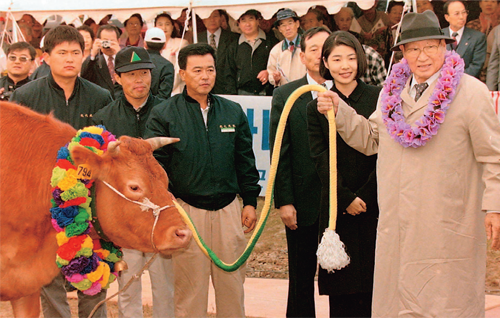
In 1998, Chung Ju-yung, honorary chairman of the Hyundai Group, initiated non-governmental exchanges and economic cooperation between North and South Korea by crossing the armistice line to visit the North, delivering 1,001 head of cattle over two visits.
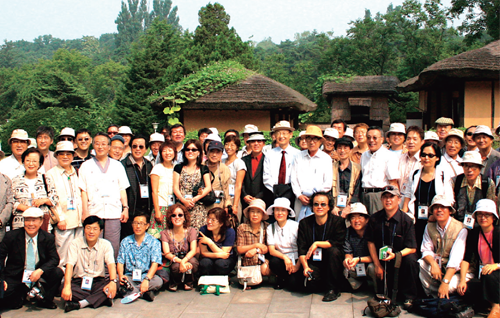
South Korean writers take a group photograph to commemorate the 2005 Korean Writers‘ Convention held in North Korea. The gathering was made possible by a reconciliatory mood d by the “June 15 Joint Declaration” adopted at the first inter-Korean summit in 2000.
In 2008, a literary magazine carrying the works of North and South Korean writers was published: “Reunified Literature” (Tongil munhak), a bulletin for the June 15 Commemorative Association, containing 33 works including short stories, poetry, essays and critiques. Fortunate enough to have my short story among them, I was able to obtain a copy of the magazine, which had finally seen the light of day after many complications. I put it on my bookshelf next to the anthology of a North Korean poet that I had received as a gift in Pyongyang. As the author of books that have been translated into multiple languages, I have often had the chance to meet foreign readers at international book fairs and literary events. That was one thing, but it was quite another to think about my books being read by North Koreans.
What was that gentle thrill that coursed through me when I first set foot on North Korean soil? What about the awkward delight I felt conversing with the first North Korean I had ever met? And what was the faint but invigorating energy that enveloped me on a solitary walk along the valley of Mt. Kumgang?
But later in the same year, North-South relations rapidly cooled, partly due to an accident involving a South Korean tourist to Mt. Kumgang. Taking an early morning walk, she wandered into a North Korean military area and was shot by a sentry. The Mt. Kumgang tour program, which had steadily grown to attract more than a million visitors by 2005, was immediately discontinued. For the next ten years, the government of the South did not talk with the North. In the tense atmosphere, the tour program was often criticized for having financially benefited the enemy state. In the end, however, the door was reopened.
In April this year, an inter-Korean summit was held at Panmunjom. The leaders of North and South Korea strolled to the footbridge on the border and sat on benches where they talked privately for 30 minutes. The stroll was broadcast live, but we could hear nothing but birds singing. On the following day, one news outlet attempted to use lip reading to eavesdrop on their conversation. Another report, which pleased me even more, explained the region’s ecosystem, identifying the call of each bird. I don’t believe I was alone in imagining the birds were chirping to herald an era of peace.
On my bookshelf, there are two photography collections showcasing the North Korean landscape. One is “The Mountains and Rivers of North Korea” by Hiroji Kubota, a Magnum photographer, containing photographs taken in 1979 for the Japanese magazine “Sekai.” Kubota was the fourth Japanese national ever allowed to climb the mountains of North Korea. In the book’s epilogue, he wrote: “Mt. Paektu, the epitome of a majestic continental mountain, and Mt. Kumgang, an icon of Asia itself - I was overwhelmed by the vitality and grandeur of Mother Nature manifested by the two mountains.”
The book was published in 1988 by the Hankyoreh, a progressive daily newspaper established that year with donations from the general public. Publishing such a book required a measure of courage at the time when the Cold War was still going on and South Korea was under military dictatorship. Readers were excited about the book, and I did not hesitate to buy a copy for 30,000 won, which was enough to buy 300 packets of ramyeon noodles at the time.
The Post-Division History
Another photography collection on my bookshelf is “Mt. Paektu,” published in 1982 by DPRK Pictorial in Pyongyang. I bought it when I attended the Korean Writers’ Convention. Unlike the pictures taken by Kubota, who had to work with time and permission constraints, this book features all the subtle changes of the four seasons, and the richly detailed photographs are more personal and varied. Although the level of artistry is far lower, I am as much enamored with the people’s lives captured in the photographs as with the scenery itself.
In North Korea, Mt. Paektu is held dear as a jewel of natural beauty, but its historical value as a site of independence struggles is just as important. Once home to a secret camp of the Korean People’s Revolutionary Army, the mountain has many memorial statues, towers and steles as well as preserved sites of the guerrillas’ homes and camps. Over the decades since Korea was divided, the mountain has evolved as a sacred place symbolizing the North Korean people’s own modern history - a history that is different from that of the South. Unless we understand this, we may not be prepared to enter that land.
These days, I make a lot of travel plans with my friends. We promise that if the railway is connected to run through the North-South border, and then to Russia and Europe, we’ll go visit these places in the same order, from Seoul to Pyongyang, Vladivostok, Moscow, and then to Paris. We say, why take an airplane when we can travel by train? And I want to go back to Mt. Paektu as well, not via China but directly by railway. I know, of course, that it will take a lot of time and understanding for the long-severed lines to be reconnected. But surely we can wait. Can’t we?
Tours for Peace and Reconciliation
The Demilitarized Zone (DMZ) is a strip of land approximately 4 km wide and 250 km long running on either side of the Military Demarcation Line (MDL), dividing the Korean peninsula. As the Korean War culminated in an armistice, the then frontier line was settled as the border, and the village of Panmunjom, where the agreement was signed, became the Joint Security Area and the one and only passage between the two Koreas. Today, Panmunjom and the truce facilities on the border attract almost three million annual visitors from in and outside of the country.
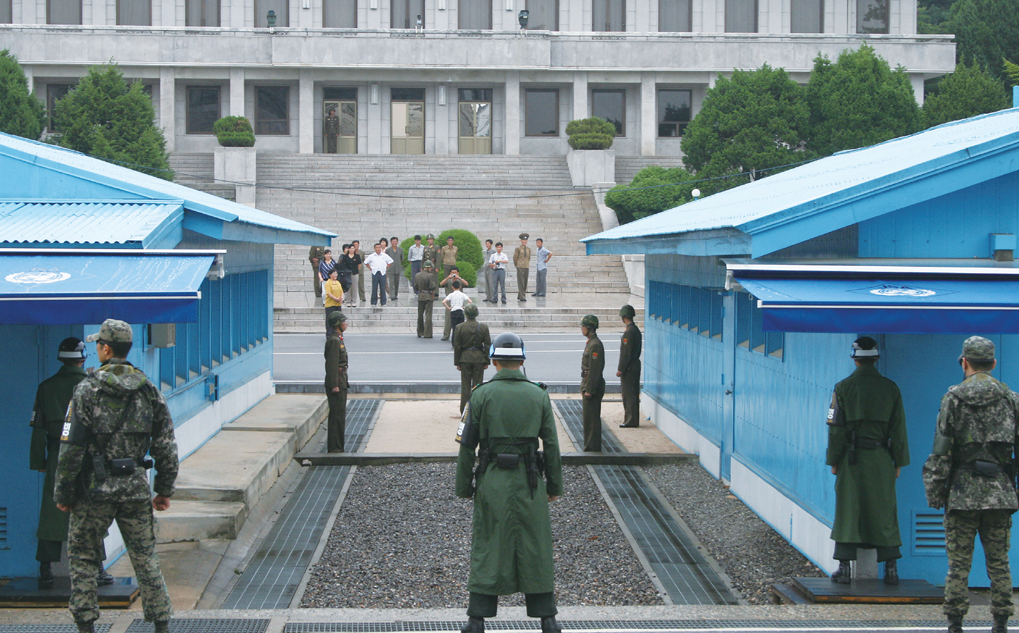
A group of North Koreans visit Panmunjom, the only passage in the DMZ. South Koreans who want to visit the truce village through socalled “security tourism” must apply at least 60 days in advance at the National Intelligence Service. Only groups are eligible.
In his book “This Kind of War,” American historian and columnist Theodore R. Fehrenbach describes the moment the DMZ was d in the ceasefire agreement signed at Panmunjom on July 27, 1953, as follows: “At 10:01 they signed the first of eighteen s prepared by each side. It took them twelve minutes to sign them all. Then, each man got up and left the building, without speaking.”
The DMZ is the Cold War’s last frontier. This land of tragedy, which seemed destined to remain a symbol of division, has suddenly begun to speak of peace. This April in Panmunjom, the place of armistice and the perpetuated division of Korea, South Korean President Moon Jae-in and Chairman of the DPRK State Affairs Commission Kim Jong-un signed the “Panmunjom Declaration for Peace, Prosperity and Unification of the Korean Peninsula” and promised to work together to bring peace to the region.
The two leaders strolling on the border footbridge was a dramatic scene that captivated audiences around the world. That day, they walked side by side, the blue footbridge vivid against the bright green woods, and sat at a small wooden table at one end. During the live broadcast of the meeting, not a word was heard, nor was there any background music. There was only the sonorant cries of thrushes and the vibrant replies of grey-headed woodpeckers.
Four Keywords
The significance of the DMZ can be understood from four major aspects. First, it is an ecological treasure trove born from the Cold War. In spite of the destructive war and the long military confrontation, nature has found a way to recover and sustain itself. According to statistics released by the National Institute of Ecology in June 2018, the DMZ is home to 5,929 species of wildlife, including 101 endangered ones. Yet, it was not by human hands that the battlefields reverted to healthy forests.
Secondly, the DMZ is a living war museum. When the plain across the Imjin River “moved” just before the Chinese army launched a major offensive during the Korean War, the British soldiers who fought here must have been painfully reminded of a scene from “Macbeth,” where the protagonist is warned to prepare for war if the forest moves. After all, the DMZ is an epic war ary filled with the memories of 63 nations who took part in the war in many ways.
The DMZ is also the birthplace of a special border culture. In the nearby villages to the north of the Civilian Control Line, the residents coexist with nature, practicing ecological morality by feeding migratory birds and reaping the rewards in the form of bird-watching tourism. Here, too, the old die, the young love, and children are born.
With a pristine ecosystem preserved over decades, the areas around the DMZ bear the scars of the Korean War, reminding visitors of the bitter reality of a divided nation.
Bridges, Symbolic and Real
The fourth key to understanding Panmunjom is its bridges. Immediately after the ceasefire agreement, the Neutral Nations Supervisory Commission built a wooden bridge on the marsh along the MDL to the east of Panmunjom to shorten the path between the conference halls. A byproduct of the Cold War, the small footbridge has now become a symbol of peace. The “April 27 Panmunjom Declaration” includes a promise to make the DMZ a peace belt, and the two leaders’ walk on the footbridge seems to be the first step in that direction.
Four centuries earlier, in 1592, King Seonjo of Joseon was fleeing northward, pursued by Japanese soldiers who had invaded through the southern coast and were advancing farther inland. When the king arrived at the small village only to find the flooded river impassable, the villagers took down their gates made of wooden panels (neolmun) and formed a bridge across the river for the king. From then on, the village was called Neolmun-ri (meaning the “panel gate village”) until the name was changed to Panmunjom, based on the Chinese characters of the same meaning, as the Chinese delegates proposed during the ceasefire talks.
Moreover, there was once a symbolic bridge across the Military Demarcation Line. In November 1984, Vasily Yakovlevich Matujok, a tour guide for the Soviet Embassy in Pyongyang, sought asylum after crossing the MDL, running between the buildings where the Military Armistice Commission was holding a conference. Another southbound crossing occurred in November 2017, when a North Korean soldier defected by running across the line, wounded by gunshots from the North.
In June 1994, former U.S. President Jimmy Carter visited North Korea through Panmunjom to intervene in the first North Korean nuclear crisis. A few years later, the founder of the Hyundai Group Chung Ju-yung visited the North twice, in June and October 1998, each time with a gift of 500 cattle in a convoy of trucks, laying down what is probably the most spectacular “bridge of peace” since division.
Steps Toward Peace
Recently, “security tourism” has attracted a growing number of tourists from Korea and abroad to visit Panmunjom and the DMZ area. Yet access remains restricted. Visitors must go through a security check to enter the area and move along a predetermined course; they can visit only during the daytime, led by a guide, and are not supposed to take photographs without permission. In spite of all the restrictions, many people head for Panmunjom to experience its unique Cold War legacy, a historic site where they can ponder the meaning of war and peace.